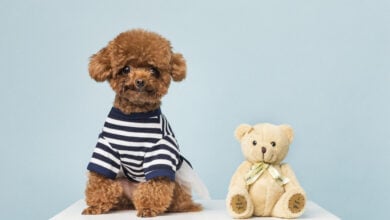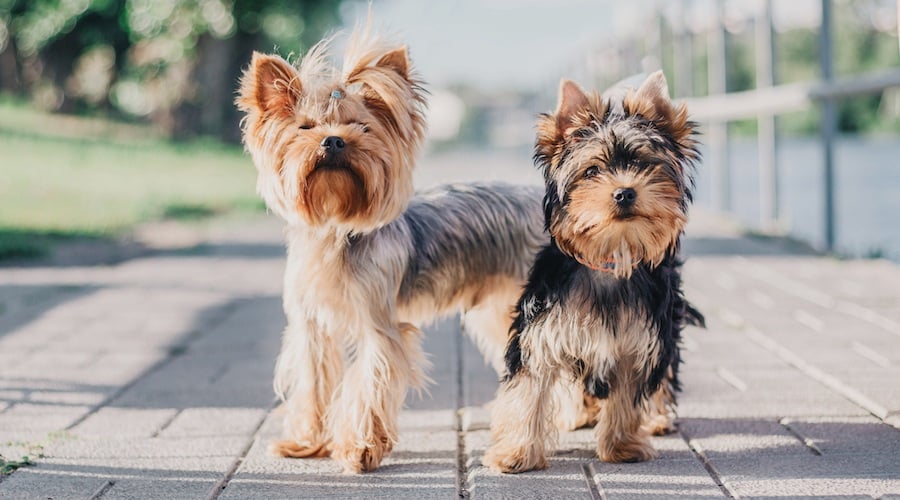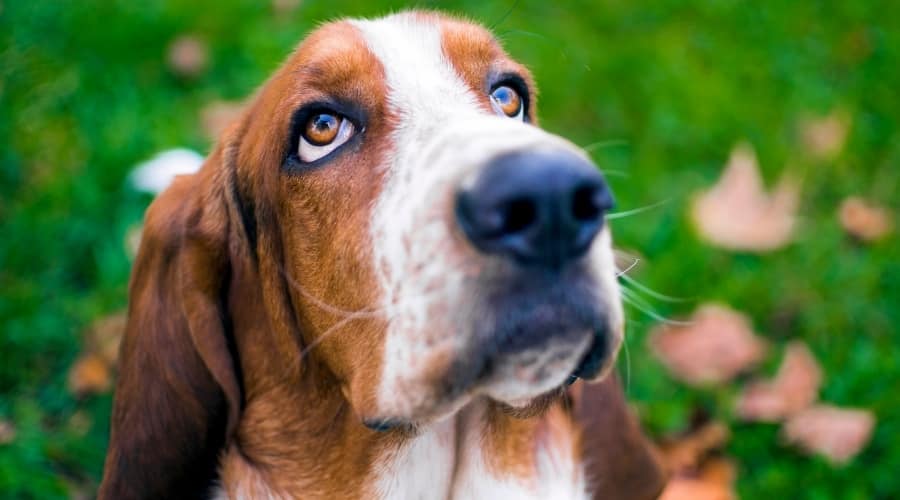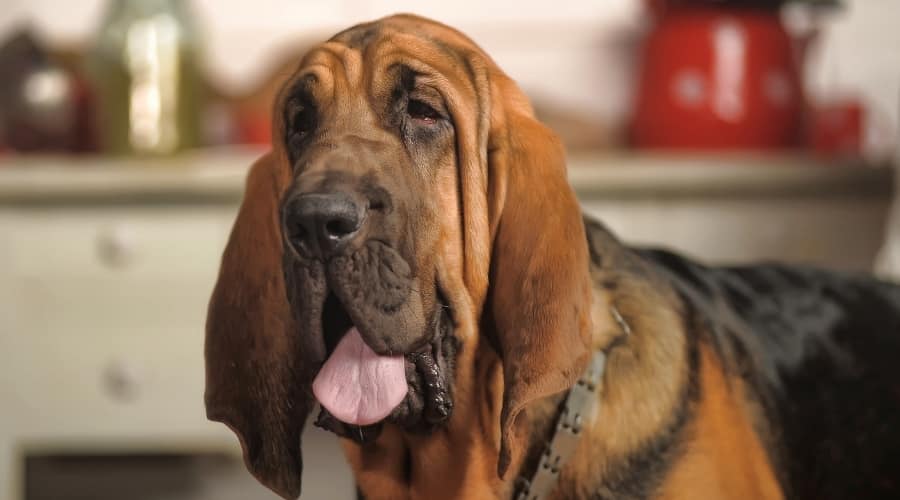Akita Dog Breed Information: Facts, Traits, Pictures & More
When you purchase through links on our site, we may earn a commission. Here’s how it works.
The Akita is a big and bold dog breed. They are often described as one of the world’s most loyal dogs. Akitas are deeply affectionate and sweet with their family but very suspicious of anyone outside of their human pack. They are a lot of dog packed into a stocky body, and not everyone has the knowledge or experience to handle the breed.
Table of Contents
Akitas are relatively rare in the United States. However, it’s not uncommon to see strong-willed dog breeds end up in shelters, and the Akita is precisely that. They can be headstrong and stubborn, so I suggest looking at another breed if you are a first-time dog owner. However, if you have experience with independent dogs, the Akita can make an excellent family companion and home guardian. I go into everything you can expect when welcoming one of these pups into your home.
Breed History
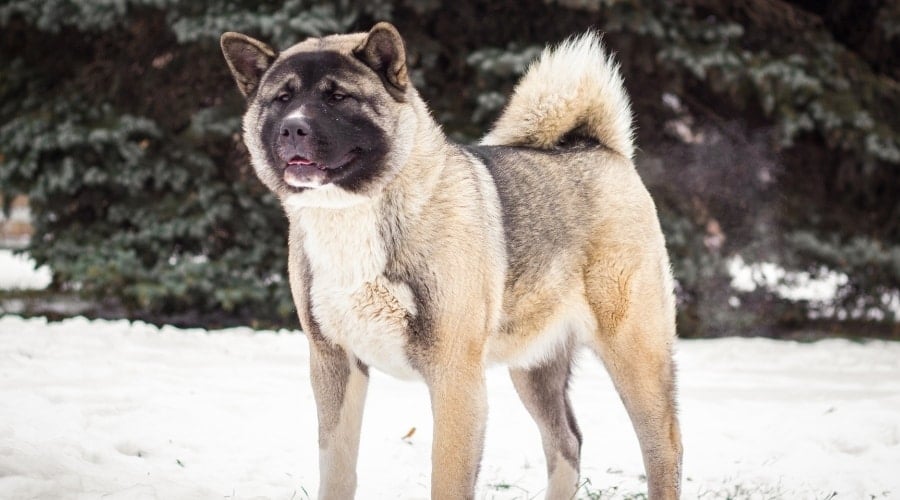
The Akita isn’t that ancient compared to many other dog breeds. The Akita, sometimes called the American Akita, is a descendant of the Japanese Akita. Japanese Akitas were developed in Japan in the 17th century. Legend has it that an emperor banned a wayward nobleman to Japan’s northern islands to live out his days as a provincial ruler. This nobleman was a huge dog fan, and he tasked his men to breed a powerfully large Spitz-type dog to hunt and protect his lands.
After generations of breeding, the Akita was born, a hardworking dog who adored their humans. Their high prey drive and sheer power meant they hunted wild boar, deer, and the Yezo bear with ease. Initially, only the imperial family and courts could own Japanese Akitas. But over time, the masses were allowed to enjoy their company too. The Akita nearly became extinct during the World Wars. Thankfully, breed fanciers focused on preserving the breed, and Dewa and Ichinoseki Akita bloodlines were favored.
While visiting Japan, Helen Keller received an Akita as a gift, which she brought back to America. But it wasn’t until soldiers returned from Japan after WWII that the breed became well-known and popular in America. It was the Akitas from the Dewa lines, which had European Mastiff influences, found their way to the U.S. According to the American Kennel Club (AKC), the Akita is routinely found in the top 60 breeds in America.
We have an in-depth guide on American Akitas vs Japanese Akitas, exploring their similarities and surprising differences. We also have a guide on other majestic Japanese dog breeds.
Temperament
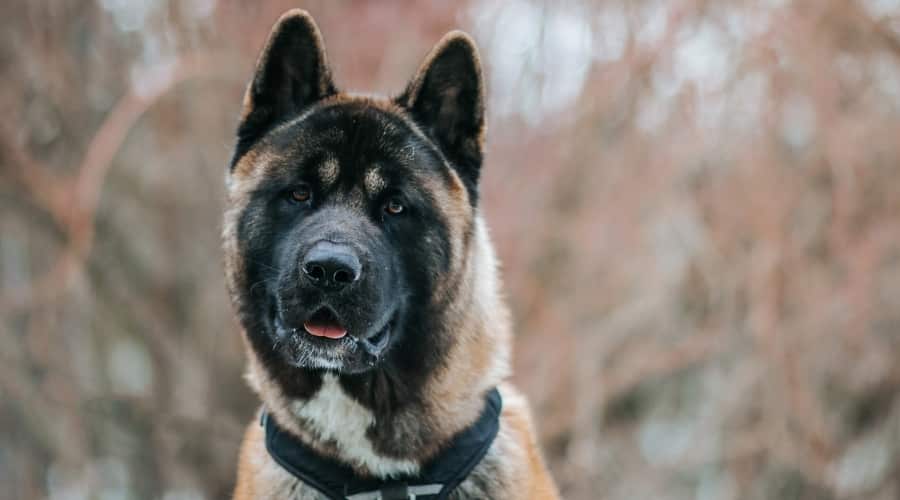
The Akita has a strong and dominant personality that not everyone can handle, especially first-time dog owners. They need a family that can commit to lifelong training and strict home rules. They must have a strong leader who they can look up to. An unruly, dominant dog does not make for a happy household.
If you can offer them the leadership they need, they can make a fantastic family dog who protects you with their life. The AKC describes them as profoundly loyal. When their owners are threatened or attacked, they can go from cute to fierce in one second flat. If you are looking for a family guard dog, it’s hard to do better than an Akita.
Akitas are also very lively and love to be the center of attention. They crave attention and want to be played with constantly, making them a fun family companion. They are great with older children, but because of their vast size, they should always be supervised when around kids. Some Akitas are known to be aggressive towards other dogs, especially same-sex aggression.
Their love of humans and attention-craving means they hate to be left alone for long periods. This is surprising for many dog lovers out there. Many think you can leave the Akita to get on with their day without much attention. But try this at your peril, and you’ll soon find an unhappy and destructive dog on your hands. Their intense personality and dependency are traits that sadly land this breed in shelters.
This loyal and sensitive soul is why many people fall in love with Akitas. They see themselves as lap dogs, so prepare for dead legs and squashed movie nights. Plus, they make the best furry hot water bottles. The label gentle giant suits the breed very well until you mess with their family, of course. I have previously owned an American Akita mix called Babs, and she was the most loyal and sweetest doggy soul I’ve ever met.

Photo by Emma Braby for Canine Journal, © Cover Story Media, Inc. 2024.
Appearance
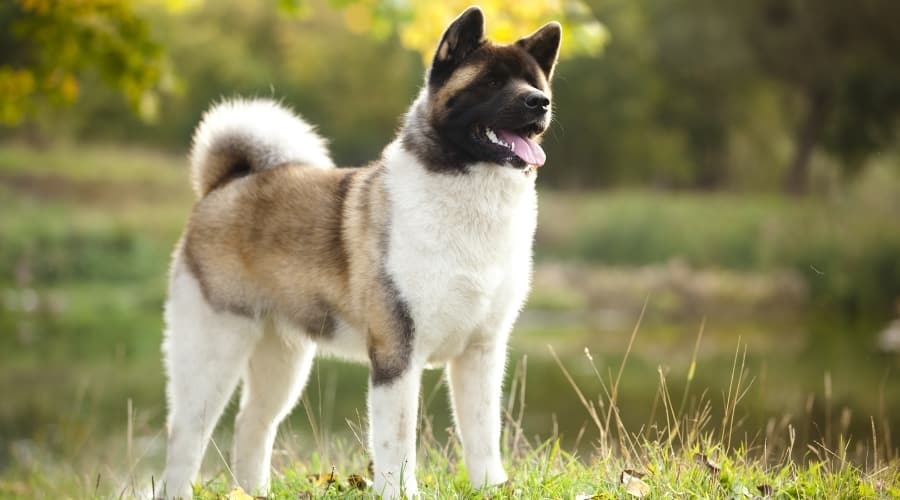
The Akita is the largest of the Spitz-type dogs. They measure 24 to 28 inches tall and weighs between 70 and 130 pounds. A pooch over 100 pounds is considered to be a giant-sized dog. The Akita is a thick-set dog with substance and heavy bones.
Their neck is thick and muscular, carrying their head with pride and alertness. They look similar to Siberian Huskies and are often compared to them. The Akita is bear-like in appearance, and their breed standard describes their head as massive, which it is! The Akita’s jaw is broad, and their nose is square and fleshy, leading up to relatively small triangular-shaped eyes. Their ears are always erect and, again, small compared to their head.
These pups have large paws, but they are cat-like and rounded. An Akita’s tail is their most distinctive feature. It is thick, fluffy, and curls like a Catherine wheel up their back. When they get excited, their tail wags from side to side, but it spins around like helicopter blades because it is curled. Unlike many giant dog breeds, their dewlaps are minimal, which means they don’t drool as much compared to others.
Coat & Colors
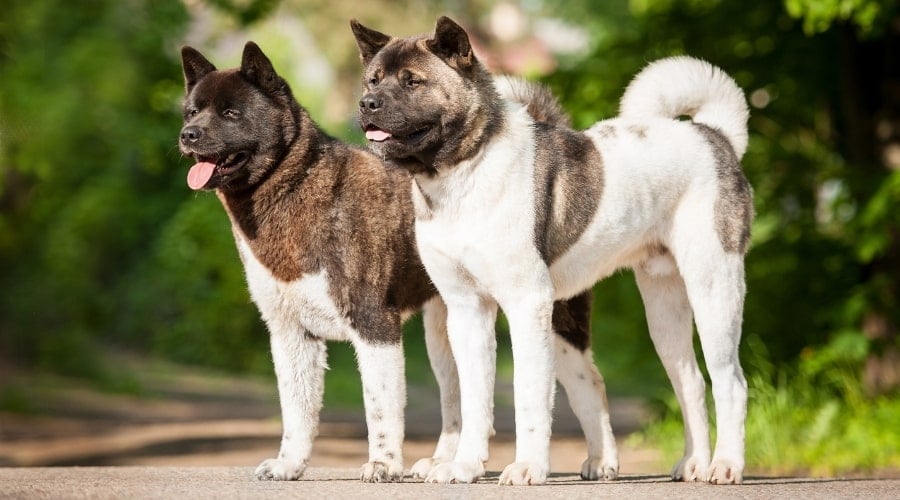
The Akita has a thick double coat. The underlayer is soft and downy, keeping their body warm. Their outer layer is longer and slightly harsher, making it weather resistant. However, it is still soft to the touch. Akitas are heavy shedders, which I discuss more in the grooming section. But you need to take this into account if you welcome one of these pups into your life. The Akita life is a hairy one!
The longest part of their coat is the hair on their shoulders and rump, which measures around two inches long. The hair on their tail is between two and three inches long and profuse. The rest of their coat is shorter and usually around one inch in length. The texture of their beautiful coat is soft and straight.
Akitas have a variety of coat colors to choose from: black, brown, brindle, fawn, red, silver, and white, sometimes with a black overlay. Their coats are usually a mixture, but sometimes they can be a solid color. The mixed-colored coats are sometimes known as ‘pinto’ coats, similar to cattle: white with large patches of color that take up at least a third of their coat. Many American Akitas have a black mask covering their face or whole head. This mask is often a “giveaway” between an American and a Japanese Akita, as the Japanese variety does not have black masks.
Exercise Requirements
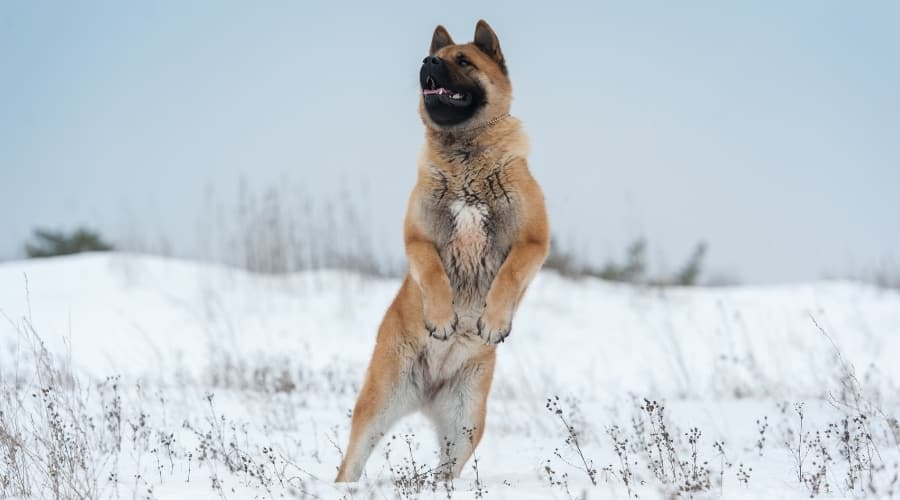
The Akita is an energetic dog breed that requires at least 60 minutes of intense exercise daily, preferably more. Because of their large body and heavily laden joints, I do not suggest high-impact exercise such as hour-long running. However, their activity needs to be active, and adventurous walks and playing in the park are great examples of the type of exercise they enjoy.
The Akita is an intelligent dog who can quickly become bored and restless. So, be sure to mix up their activity throughout the week. Mundane walks around the block every day will not stimulate their active mind. Bored Akitas become destructive quickly, and you’ll soon know if you aren’t entertaining them enough. Between exercise sessions, they also need interactive play with their family and access to various dog toys to keep them entertained.
As a puppy, you need to take it easy regarding exercise. In the sense that their developing bones and joints should not be subject to high-impact exercise. Avoid highly impactive exercise until they are at least 18 months old. Akitas are already prone to joint health problems, so it’s important not to make this worse.
Living Conditions
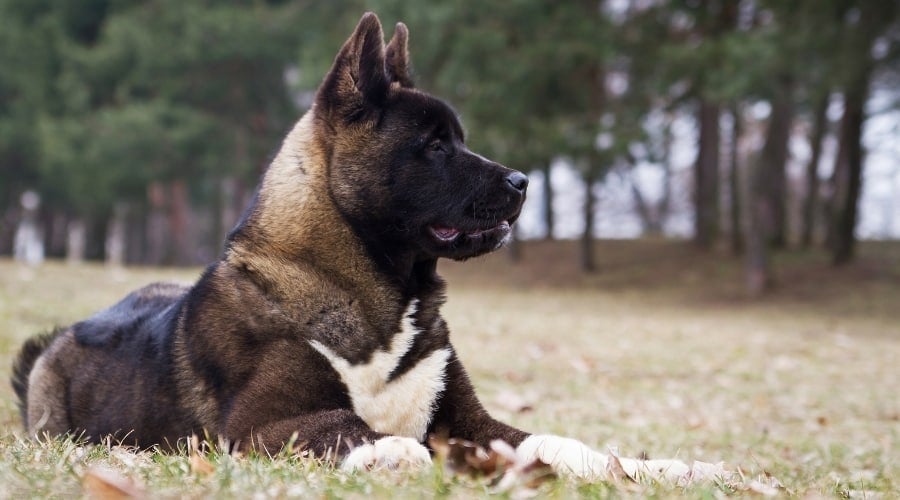
It goes without saying that this large to giant-sized dog breed is not made for apartment life. They need a larger home, preferably with access to a secured yard. This pooch is used to the mountainous ranges of the Japanese mountains and likes fresh air in their nostrils. Akitas get cabin fever if you keep them cooped up all day long. These pups aren’t like some other giant breeds that sleep all day. They need an active owner who can take charge of their daily exercise needs and manage their big personalities.
Training
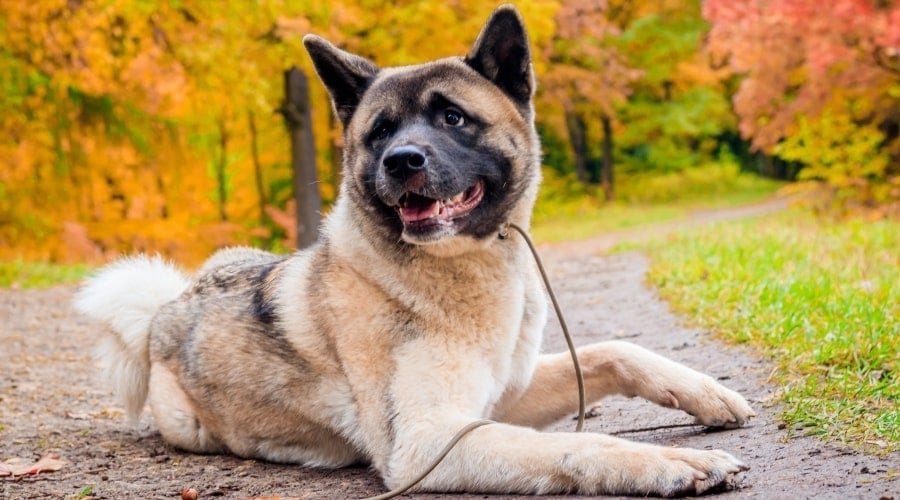
The Akita is a highly dominant dog who needs a strict master to take the lead. It’s wise to learn about dominant dogs and pack mentality. However, if you’re a first-time dog owner, this is not the best breed. Both you and your Akita will be much happier if you have previous experience with large dominant dogs.
Akitas are intelligent and very stubborn. This is another reason why you should only take them on if you have experience. The Akita does things on their schedule, not yours. Start obedience training when young, and make sure to keep training sessions fun because they love to play.
Firm but fair is best, so be consistent with their training. The Akita is a sensitive dog and will sulk if you shout. It’s important with dominant dogs that the whole family gets on board with the training. Use the same command words, stick to the rules, and make them work for food and toys. If you give in, you’ll lose the training battle.
The Akita must be socialized as a young pup; without this, they can become dangerous dogs. Their sheer power, intense loyalty, and innate protectiveness needs to be shaped into a well-balanced pooch. This starts with socialization, and it is a lifelong training commitment. Consider crate training to reduce your Akita’s anxiety levels. The breed is known to suffer from separation anxiety.
Working with a professional dog trainer like Doggy Dan or using an online dog training course can help make the Akita training journey much smoother.
Health
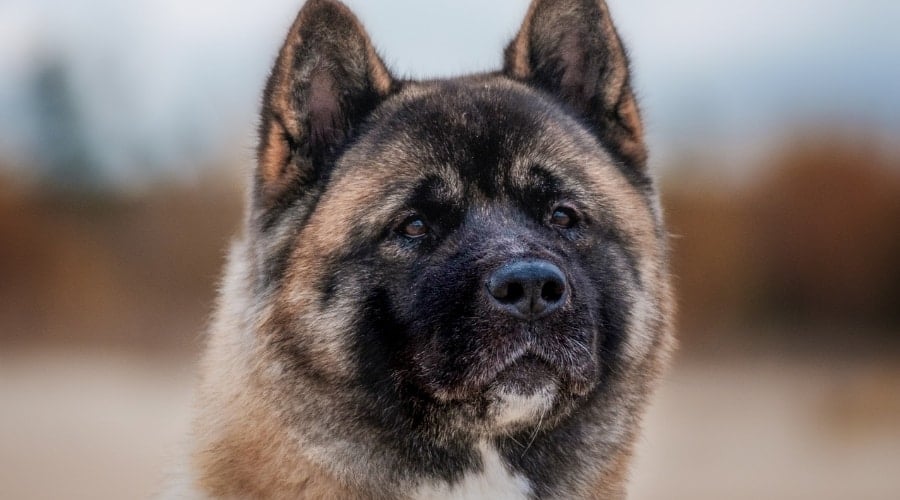
The Akita is a relatively healthy dog breed, considering their size. Many large dogs have a shorter lifespan than smaller breeds, but Akitas typically enjoy 10 to 14 years. Exercising them regularly, keeping them up-to-date with vet checkups, and feeding them a high-quality diet is crucial. Like all dog breeds, the Akita is prone to specific health conditions. Look at the common Akita health problems below and learn about the symptoms to look out for.
Hip Dysplasia
Hip dysplasia affects the hip joints of many large dog breeds. Because the Akita puppy has lots of growing to do, their skeleton develops rapidly. This can result in uneven growth and grinding and accelerate joint damage. Joint dysplasia is painful and can cause arthritis in later life. Symptoms to look out for are stiffness during exercise, lameness in the rear end, and difficulty standing up or climbing the stairs.
Eye Conditions
The Akita is prone to various eye concerns, including progressive retinal atrophy (PRA) and cataracts in later life. If you notice any changes in their vision or the appearance of their eyes, it’s crucial to consult your vet. Without treatment, both of these conditions can lead to complete blindness.
Thyroid Disorders
The Akita is prone to hypothyroidism, which is where the body doesn’t produce enough of the thyroid hormone. This can cause tiredness, hair loss, skin problems, weight gain, depression, and other concerns. Some Akitas are known to suffer from a condition called seborrhea, which is often mistaken for hypothyroidism.
Bloat
The Akita is prone to a life-threatening condition known as bloat. This is common in many large-breed dogs. Although it’s unclear what causes bloat, it’s crucial to never feed your dog immediately before or after exercise. This is when the condition is more likely to occur. Feed their daily allowance across at least two meal sittings, and using slow-feed bowls can help, too.
Best Pet Insurance For Akitas
It’s wise for all dog owners to consider pet insurance for their pups. Pet insurance can help cover the cost of care in an emergency, potential hip dysplasia surgery, lifelong conditions such as hypothyroidism, and much more. Having a plan allows you to concentrate on their health and recovery instead of finances. Our pet insurance experts cover the best pet insurance for Akitas to help owners find the right plan. You can also use our free pet insurance quote puller below.

Nutrition
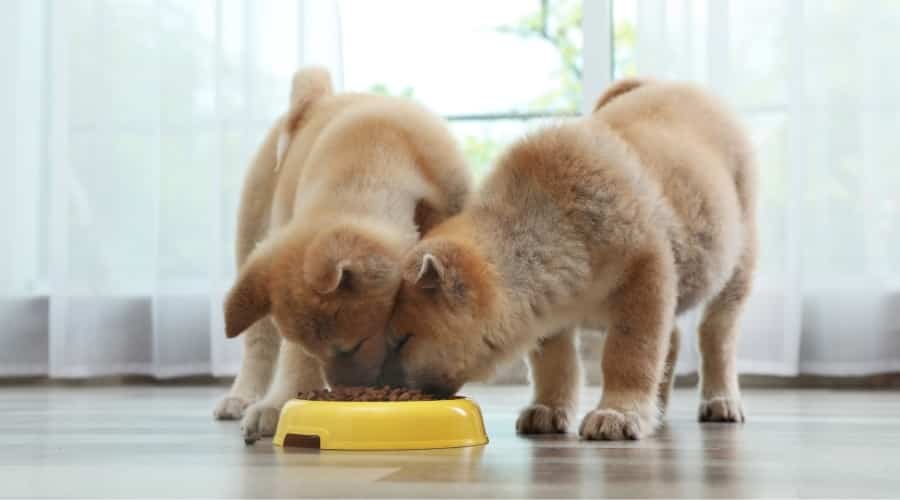
The Akita is a large to giant-sized dog that needs substantial fuel to sustain themself throughout the day. Depending on their size, age, and energy levels, they typically need between four and six cups of food daily. Always follow the package instructions, and do not overfeed your pup because they will become overweight.
The breed has various life stages, each with different nutritional requirements. It’s important that you learn about these and feed your Akita the right dog food according to their needs. A high-quality diet provides a balanced diet, including omega fatty acids to care for their skin and coat. Ideally, you should feed them food designed for large and giant breeds. Large-breed puppy food is essential to their development at an early age. These diets have the optimum ratio of nutrients to control rapid bone growth during puppyhood, which can decrease their chances of developing hip dysplasia.
Additionally, many vets advise that Akitas be fed light or low-calorie diets from seven years old. This can help decrease their chances of developing kidney disease and manage their weight. Akitas are more prone to obesity than many other dog breeds.
Grooming
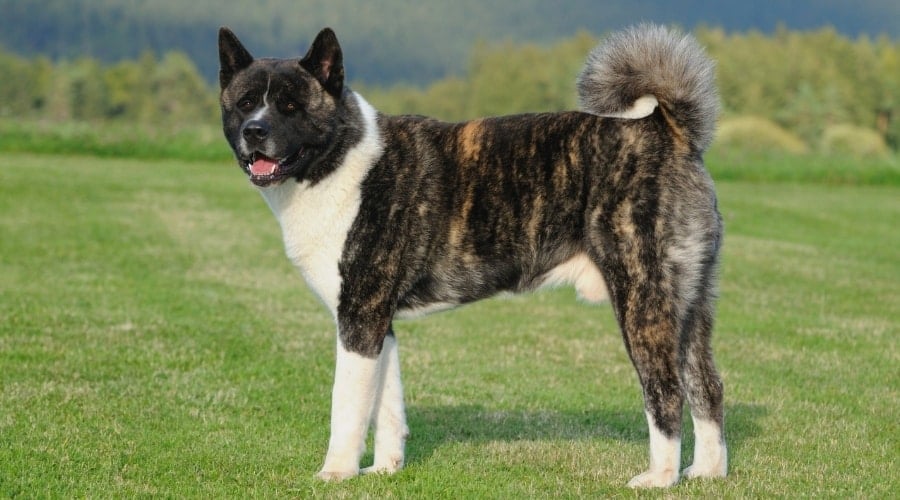
The Akita has a thick double coat that requires a fair bit of grooming. Thankfully, because it is straight, it is relatively simple but takes a fair bit of time. Throughout the year, they need brushing two or three times a week. During the shedding seasons, you should increase this to most days if you want to control hair clumps floating around the home. A de-shedding tool is needed for successful grooming during the shedding seasons.
For a large or giant dog, the Akita is relatively clean and rarely suffers from doggy odor. They only need bathing once every 8 to 12 weeks or so. But never more than this, as you risk irritating their skin and ruining their natural coat oils. Their fluffy and soft coat will appreciate a conditioning shampoo to keep them looking their best. Always dry them thoroughly after a bath because a damp undercoat is uncomfortable, leads to skin infections, and can cause mold.
The rest of their grooming schedule is the same as any other dog breed. Clean their teeth at least once a week with a doggy toothbrush and toothpaste to prevent periodontal diseases. Trim their nails as and when they get too long, which is usually around once a month.
Puppy Costs
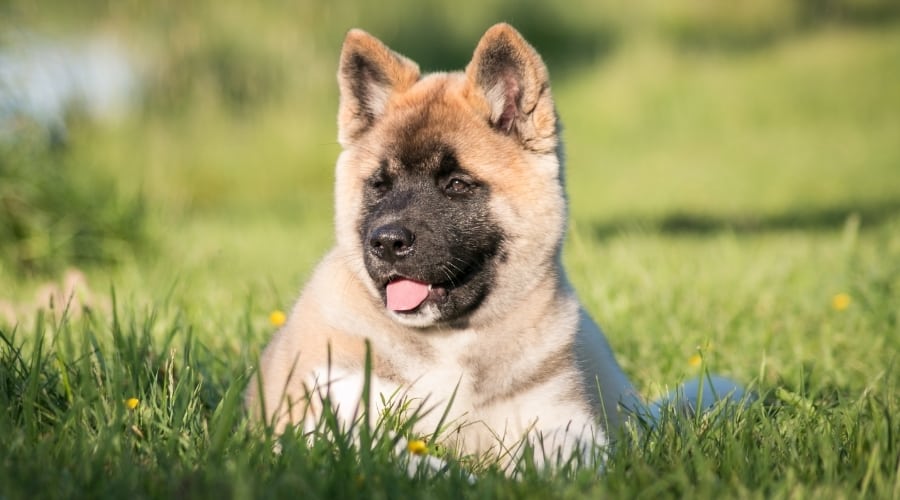
Always work with a reputable breeder who raises their pups with love, socialization, and medical attention. Look for those with years of experience and insist on meeting you at the place where the puppies are raised. Always meet the pups and the mother, and see health certificates before you make any commitments. The average price of a purebred American Akita pup is around $1,500.
Never work with a puppy mill or those offering a puppy for much less than the average price. Poor-quality breeders do not socialize their pups, which leads to untold behavioral problems. They also are unlikely to screen for health concerns, leading to expensive medical bills after purchase. Please do your research. A great place to start is with the AKC’s list of reputable Akita breeders.
In addition to the puppy cost, you must consider the ongoing costs of owning an Akita. As a large to giant dog, everything you buy will also be large or giant, costing more. XXL crates, beds, toys, and higher food and insurance bills mean that you need to be sure that you are financially able to care for them.
Rescues & Shelters

Considering that Akitas occasionally show up in rescue shelters across America, you should also consider adopting a rescue. Head to your local rescue center and speak to the staff, who can hopefully point you toward an Akita and walk you through the adoption process.
Adopting is likely much cheaper than buying from a breeder, and you could save a dog’s life, too. There are also many dedicated rescue shelters that focus solely on rehoming Akitas. The Akita Club of America lists several rescue organizations, so be sure to check there to see if an Akita rescue organization is near you.
As Family Pets
- This is a dominant dog who needs an experienced family.
- They are a very protective and alert dog who makes one of the best guard dogs in town.
- Akitas need to be exercised at least 60 minutes every day.
- You’ll also want to dedicate lots of playtime in between.
- They love to be the center of attention and hate to be left alone.
- Akitas are affectionate with their family and will squash you on the sofa.
- Their training is a lifelong commitment requiring a firm pack leader to be happy.
- They need a large family home with access to a secured yard.
- The breed can live with older children and sometimes other dogs (but not always).
Other Dog Breeds Similar To Akitas
The Akita is the epitome of a human’s best friend. But if you’re unsure this is the breed for you, there are many other handsome hounds to consider. The Cane Corso is another giant breed that makes an awesome family protector. If you love big-hair energy, the Alaskan Malamute could be the answer to your doggy dreams. Lastly, the American Pitbull Terrier is smaller but just as sweet and might be more suited to a first-time dog owner.
Do you have an Akita? Or are you thinking about welcoming one into your life? If you have a story to share or a question to ask, let us know in the comment section below.
Why Trust Canine Journal?
Emma is a dog mom to two rescue dogs, Bonkers and Chips. American Akitas are one of her favorite breeds, and she previously owned an Akita mix called Babs, a sweet but sometimes defiant madam. Before joining the Canine Journal team, Emma was a full-time dog walker and sitter. She is passionate about sharing her canine knowledge and experiences with her readers. Emma works with a dedicated team to ensure Canine Journal remains a reliable and current online dog resource for all.
